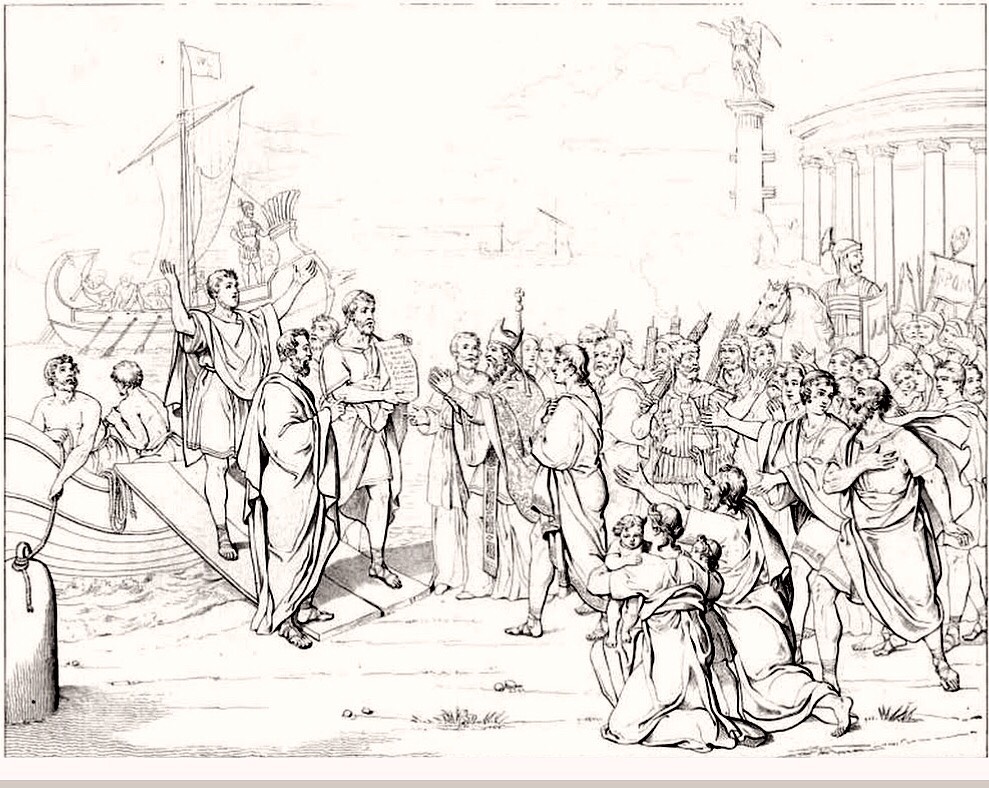Half way through August, in 1842, during the secular celebrations for the Patron of Messina, the Madonna of the Letter, with dazzling light decorations, the painter, Michele Panebianco, created a number of transparencies, which were lit from the back to display their magnificently bright colors, in order to adorn the main streets of the city.
These transparencies depicted historical scenes with knights, swords, helmets and decoratively adorned weapons.
Next to the Benedictine Monastery, the transparency which
represented don Giovanni of Austria, as he was about to depart for Lepanto, in
the imposing light of the cathedral of
Messina, as he received the banner, blessed by Pope Pio V from the archbishop, was
laid out from one side of the street to
the other.
If one followed the broad, straight Via
Ferdinando, to where the stage was set up for the musical entertainment for the
festivities in Saint Francesco of Paola Place, it was possible to admire the
transparency which represented the return to Messina of the Ambassadors from
Jerusalem, as they carried the Letter of
Divine protection from Mary to the people of Messina.The complex
decorative composition, which included sailors and the local population, centurians and
soldiers, with a view of the
Straight and the Calabrian hills in the background,
highlighted Paul the Apostle, alongside one of the first bishops of the Church
in Messina, Bachilo standing next to the
anchored ship. The sweet and tender
figure of a young mother is depicted holding up her baby to be blessed. Tommaso
Aloysio Juvara used the preparatory drawing for this to produce a lithographic
engraving.
In that part of Messina where, during the War of the Vespers, the people of Messina humiliated the Angevins, a tranparency devised and drawn by Panebianco (but painted by others), was hung. It represented the glorious entrance into Messina of the Norman Count Ruggero, conqueror of muslim Sicily. (Mariani produced an engraving from it). This iconographic theme, essential in the Norman times, but which also played a major role in the history of the city of Messina, was used liberally by Panebianco, in the sense that he introduced anachronisms and stretched the theme to its limit. These latter were noticed and reported by his contemporaries. We will refer back to this a little further on but it is enough to say that Ruggero brandishes a flag which has a cross rather than the traditional image of the Madonna on it. Why does Panebianco substitute one for the other? The presence of the Monarch in Messina (on 12th August the Bourbon King Ferdinand II visited the city)prompted the artist to see an episode of medieval history in a different light, choosing to depict it as “religious patriottism”. In this particolar historic episode, there is a strong allusion to the Monarchic unity of the Mezzogiorno and to the Apostolic Legacy (one of the prerogatives of the Sicilian monarchy) introduced in 1098 in a document signed by Pope Urban II and handed to Ruggero, Grand Count of Sicily. In short, Panebianco is seen to have depicted these scenes with the aim to symbolize and reclaim the power of the Monarchy over the Church. Ten years later, the Boubon King Ferdinand II returned to Messina once again and Panebianco, created a transparency depicting the same iconographic theme with the same title. Only a detailed stylistic comparison of the two transparencies will show whether or not the revolution in 1848 which interposed the two operas, made any change to Panebianco’s stylistic and/or political perspective.

